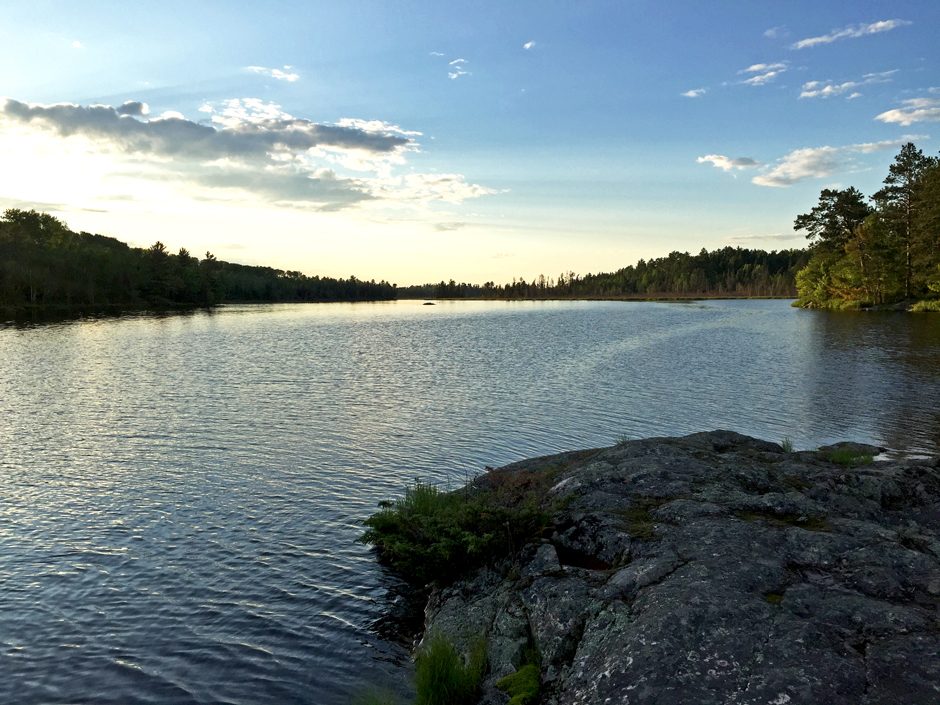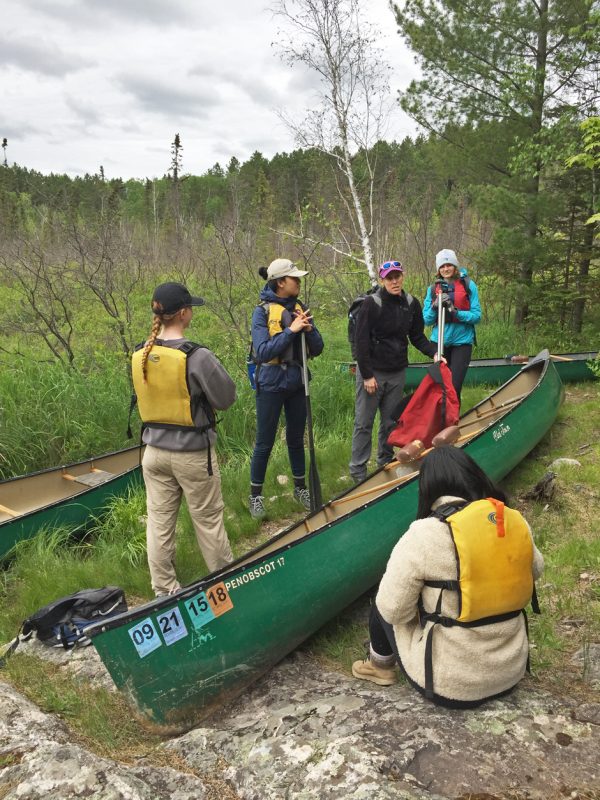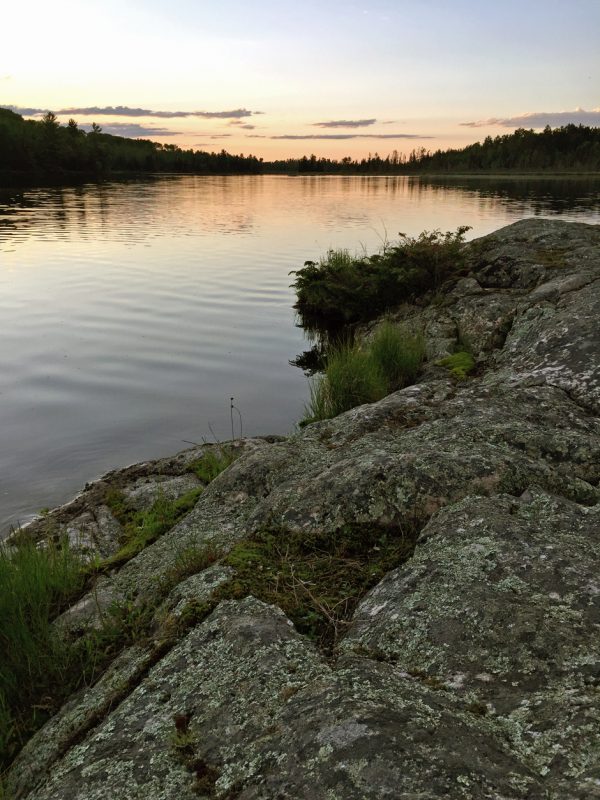Coe College Wilderness Field Station Features Education, ARUs and Avian Research
 The Wilderness Field Station is located on Low Lake, seen here looking north from the best swimming spot on the lake. (Photo credit: Jesse Ellis)
The Wilderness Field Station is located on Low Lake, seen here looking north from the best swimming spot on the lake. (Photo credit: Jesse Ellis)If someone speaks to Jesse Ellis, Assistant Professor of Biology at Coe College and Director of the Wilderness Field Station, they might get interrupted; by a blue-headed vireo.
“Bird songs are a big part of data gathering for research here,” says Ellis. “We use automated recording units (ARUs) to record wilderness sounds, especially sounds made by birds and frogs.”
The Wilderness Field Station is a teaching-oriented facility. “In addition to our annual summer classes, we also conduct bird studies here including bird counts in transects, and researchers from other colleges come here to do multiple lake samplings,” Ellis adds.
Located in the Superior National Forest in Northern Minnesota, the Wilderness Field Station offers two field study sessions in the summer, featuring small classes and personalized instruction. Courses are part lecture, part laboratory investigation and part canoe adventure. In terms of summer classes for undergraduates, there are two sessions: one beginning in mid-June, the other one in mid-July. Both sessions are 28 days in length and include courses in aquatic ecology, conservation in the wild and environmental justice. Wilderness sustainability, animal behavior, and writing about the wilderness are some of the topics covered. Boreal habitats are used for case studies. The impact of the Ojibwe tribe in the area is also explored. There are also multi-day canoe adventures in the Boundary Waters Canoe Area Wilderness.

Carrie Kissman gives canoe loading tips. (left to right) Marissa Cartwright (Coe College), Rebecca Chen (Carleton College), Carrie Kissman (Aquatic Ecology instructor, St. Norbert College) and Erika Mitchell (Carleton College). Athena Aguilar (Coe College) is seated. (Photo credit: Jesse Ellis)
Research efforts center on gaining a better understanding of area birds and their behaviors, a task for which Ellis is uniquely suited. His educational background includes animal neurological behavior, ornithology and acoustic monitoring, which he puts to good use at the Wilderness Field Station. “Using the ARUs in the wilderness is one way of documenting changes in the habitat. As global warming happens, this area is likely to gradually change over to oak savannah. We will be able to hear the differences as the habitat changes and species change,” he says. There are currently two ARUs in use at the field station, with Ellis hoping to obtain grant money to put up a few more. The ARUs used are Wildlife Acoustics, Song Meter SM4s.
Birds found at Wilderness Field Station during acoustic surveys include wood-warblers, pine warblers, Blackburnian warblers, chestnut-sided warblers, mourning warblers, Tennessee and Nashville warblers, Veeries, hermit thrush, Swainson’s thrush and loons. The ARUs have also picked up bald eagles, ospreys and northern waterthrush. Sounds of moose have been picked up, as well as wolf packs and barred and Northern Saw-whet Owls. The Wilderness Field Station also harbors wood frogs, mink frogs, boreal chorus frogs, spring peepers and red squirrels, which has been determined by researchers listening to the ARU recordings.
There are also six trail cams in use, Browning Strike Force Pro XD trail cameras. “They’re nice!” says Ellis.
“The Wilderness Field Station is primarily educational in its mission, but research is important here too. It’s my third year here,” says Ellis. “In addition to teaching, I’m trying to get in as many research interests as I possibly can.”
Speaking about some of the research he is involved in at the Wilderness Field Station, Ellis elaborates, “I’m a behavioral ecologist, and I’ve been involved in a fascinating oven bird study. I’ve never recorded the same oven bird song twice at night, which is just amazing. But they only do this at night. The ovenbirds sing only one song during the day, over and over, but at night they go wild. We’ve never recorded the same song twice from night singing birds, nor from their neighbors. I’ve been looking at their song structure and trying to figure out why they do it.”

The Wilderness Field Station is located on Low Lake, seen here looking north from the best swimming spot on the lake. (Photo credit: Jesse Ellis)
Ellis has already collected three years of bird study data, which will be used as baseline data for the Wilderness Field Station. “There is bird and aquatic monitoring, but we do not currently have vegetation monitoring, as there are not currently a lot of students interested in plant monitoring here,” he says.
In terms of aquatic monitoring, there are 30 lakes monitored in the area. Water quality and clarity are being monitored, as well as chlorophyll levels. Invertebrates are also being monitored. “Carrie Kissman is an aquatic ecologist from St. Norbert University in Wisconsin, and she leads aquatic monitoring efforts at the Wilderness Field Station,” Ellis notes. “Five years of aquatic data have been gathered so far.”
In his three years at Coe College Wilderness Field Station, Ellis has been enjoying the teaching and research, and the place-based nature of his position. “I love being up North,” says Ellis. “I have an office, but I also live in a cabin, and I can see the lake from there. Here in Ely, Minnesota, we’re North of the Western Boundary Waters.”
Ellis hopes to acquire more ARUs, continue his avian studies and instruct multitudes of students on wilderness issues.
“It’s important for people to understand the biological and human value of an area with little human influence, like this one,” Ellis emphasizes.
For more on Coe College Wilderness Field Station, see:
For more on the ARUs in use at the Wilderness Field Station, see:




0 comments